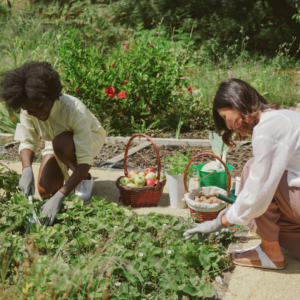Hey there, friends!
Have you ever walked past an empty lot in your neighborhood and thought, “Hey, that would make a great garden”? Well, you’re not alone! Community gardens are like little pockets of paradise in the middle of our concrete jungles. They’re places where neighbors come together to plant, grow, and, most importantly, connect.
Let’s Talk Benefits
Okay, let’s break it down. Why should you care about community gardens? Well, for starters, they’re a fantastic way to get fresh, healthy food right in your own backyard (or front yard, or rooftop—you get the idea). Plus, they’re a hub of activity, where you can meet new friends, learn new skills, and maybe even pick up a few gardening tips along the way.
Getting Started: It’s Easier Than You Think
Now, I know what you’re thinking: starting a community garden sounds like a big, scary project. But trust me, it’s not as hard as it seems! Start by chatting with your neighbors and seeing if anyone else is interested. Then, scout out potential locations—think unused lots, schoolyards, or even that awkward corner of your local park.
Once you’ve found a spot, it’s time to get permission. Reach out to the city or the property owner and see if they’re on board. And hey, don’t forget to gather up some basic gardening tools—shovels, rakes, and maybe a wheelbarrow if you’re feeling fancy.
Planning and Design: Let’s Get Creative
Now comes the fun part: planning your garden layout! Think about things like where the sun hits best, how much space you have, and what kinds of plants you want to grow. And don’t worry if you’re not a gardening expert—there are plenty of resources out there to help you get started.
When it comes to choosing plants, keep it simple. Stick to things that are easy to grow and that everyone in the community can enjoy. And hey, if you’ve got a green thumb, feel free to get creative! Maybe you want to plant a rainbow of flowers or try your hand at growing some exotic veggies. The sky’s the limit!

Building Community Engagement: Let’s Get Everyone Involved
Now, here’s the secret sauce to a successful community garden: community engagement. You want to get as many people involved as possible, from kids to seniors and everyone in between. Host regular workdays where folks can come together to plant, weed, and water. Throw in some fun events, like potlucks or garden parties, to keep everyone excited and engaged.
And hey, don’t forget to spread the word! Put up posters, send out emails, and shout it from the rooftops (figuratively speaking, of course). The more people you can get involved, the better your garden will be!
Sustaining and Growing: Keeping the Dream Alive
So, you’ve got your garden up and running—now what? Well, the work’s not over yet! You’ll need to keep tending to your garden, watering plants, pulling weeds, and keeping pests at bay. But don’t worry, it’s all part of the fun!
And hey, why stop there? Once your garden is flourishing, why not share the love? Donate some of your extra produce to local food banks or host a farmers’ market for the community. The possibilities are endless!
In Conclusion: Let’s Make Magic Happen
So there you have it, folks: the beginner’s guide to starting your very own community garden. It’s a labor of love, to be sure, but trust me when I say it’s worth it. Not only will you get to enjoy fresh, healthy food right in your own backyard, but you’ll also get to connect with your neighbors, build friendships, and maybe even change the world a little bit along the way.
So what are you waiting for? Grab your gloves and your gardening hat, and let’s get growing!
Building Community Partnerships: Strength in Numbers
Now, let’s talk about teamwork. Community gardens thrive when they have strong partnerships with local organizations, businesses, and schools. Reach out to nearby community centers, environmental groups, or gardening clubs and see if they’d be interested in collaborating. Maybe they can provide resources, volunteer support, or even just some good old-fashioned moral support.
And don’t forget about the kids! Schools are a natural ally for community gardens. Consider partnering with local schools to incorporate gardening into their curriculum or start a youth gardening club. Not only will you be educating the next generation about the joys of gardening, but you’ll also be fostering a sense of stewardship for the environment and healthy eating habits from an early age.
Celebrating Success: Reflecting on Our Journey
Last but not least, let’s take a moment to celebrate how far we’ve come. Starting a community garden is no small feat, and you should be proud of all the hard work you’ve put in. Take some time to reflect on the journey you’ve taken, the friendships you’ve made, and the impact you’ve had on your community.
Host a grand opening celebration for your garden, complete with music, food, and maybe even a ribbon-cutting ceremony. Invite your neighbors, friends, and anyone else who has supported your garden along the way. It’s a chance to come together, share stories, and bask in the beauty of what you’ve created together.
And remember, the journey doesn’t end here. Keep nurturing your garden, keep fostering connections, and keep spreading the joy of community gardening to others. Together, we can continue to grow, learn, and create positive change in our communities and beyond.
With dirt under my fingernails and a smile on my face,
Hannah

Summary
Community gardens are more than just patches of dirt—they’re vibrant hubs of activity where neighbors come together to grow food, build friendships, and create positive change. This guide breaks down the process of starting a community garden into manageable steps, from securing a location to fostering community engagement. By building partnerships, celebrating successes, and nurturing connections, community gardens have the power to transform neighborhoods and inspire a greener, more connected world.
Check out this beautiful list of flowers here!

